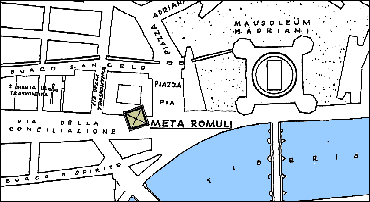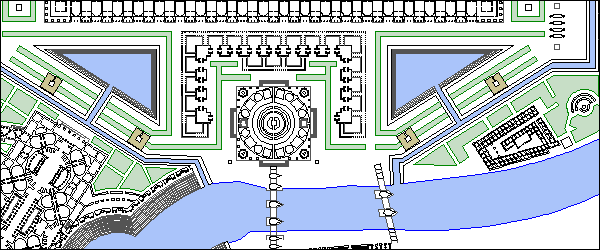Meta Romuli
1998.07.17
meta : any mark at a boundary or limit esp. the conical columns set in the ground at each end of theRoman circus, the goal, turning post : anything of conical or pyramidal form, a cone, pyramid
Until the end of the 15th century, a pyramid tomb, known since the middle ages as the Meta Romuli, stood at the intersection of the ancient Via Cornelia and Via Triumphalis. In 1500, Pope Alexander VI wished to link St. Peter's with the Castel Sant'Angelo in preparation for the Holy Year, and the part of the pyramid which would have projected into the new Via Alexandrina (later Borgo Nuovo) was pulled down. The part of the pyramid, spared by the road, remained visible until the middle of the 16th century.
Earnest Nash, Pictorial Dictionary of Ancient Rome (New York: Fredrick A. Praeger, 1961), p. 59.

Site-plan of the Meta Romuli after the 1944/49 excavations (according to information by G. Gatti). from Pictorial Dictionary of Ancient Rome.
Many traces of tombs have been found along the streets which ran west and northwest from the pons Aelius; and between 1492 and 1503 a pyramid which stood between St. Peter's and the Castel S. Angelo was removed by Alexander VI. This pyramid was regarded by some as a tomb of Romulus, and by others as that of Scipio Africanus. An obelisk, which was known in the middle ages as the obeliscus Neronis and which was situated not far from the pyramid, was also destroyed at about the same period.
Samuel Ball Platner, The Topography and Monuments of Ancient Rome (Boston: Allyn and Bacon, 1904), p. 497.
 Sepulchrum Hardiani flanked by two pairs of pyramids adjacent to the triangular stagnum.
Sepulchrum Hardiani flanked by two pairs of pyramids adjacent to the triangular stagnum.
|